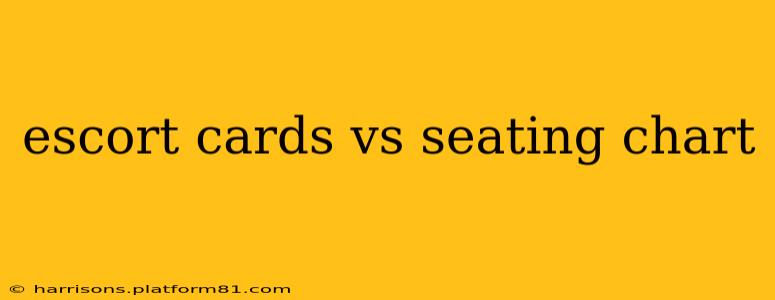Planning a wedding, corporate event, or any large gathering requires meticulous attention to detail. One crucial element often causing confusion is the difference between escort cards and seating charts. While both guide guests to their assigned seats, they serve distinct purposes and have different logistical implications. This guide clarifies the differences, helping you choose the best option for your specific event.
What are Escort Cards?
Escort cards are individual cards, typically featuring each guest's name, that direct them to their assigned table. They're presented on a display, often beautifully arranged, allowing guests to find their card and then proceed to their table. This method offers a more personalized and elegant feel, allowing for creative displays and design elements. Think elegant calligraphy, whimsical arrangements, or thematic displays tied to your event's overall aesthetic.
What is a Seating Chart?
A seating chart is a larger visual representation of the entire seating arrangement, usually displayed prominently at the entrance or reception area. It clearly indicates each table and the guests assigned to each. This provides a bird's-eye view of the seating plan, often making it easier for guests and event staff to quickly locate their assigned seats. This is particularly beneficial for larger events where navigating numerous escort cards could be time-consuming.
Escort Cards vs. Seating Charts: Key Differences
Here's a table summarizing the key differences:
| Feature | Escort Cards | Seating Chart |
|---|---|---|
| Format | Individual cards | Large visual display |
| Guest View | Find their own card; table assignment only | See their table and other guests' placements |
| Scalability | Best suited for smaller to medium-sized events | Works well for both small and large events |
| Aesthetic Appeal | High potential for elegant and creative displays | More functional; less opportunity for elaborate design |
| Ease of Use | Guests need to search for their card | Guests can quickly locate their assigned table |
Which Should I Choose for My Event?
The best choice depends on several factors:
-
Event Size: For intimate gatherings with fewer than 50 guests, escort cards often provide a more elegant and personalized touch. Larger events might benefit from the efficiency of a seating chart, particularly if guests are unfamiliar with each other or the venue.
-
Event Style: Formal events, such as black-tie weddings or galas, often lean towards escort cards for a sophisticated feel. More casual events might find a seating chart equally suitable.
-
Venue Layout: Consider the space available for displaying escort cards or a seating chart. A cramped entrance might necessitate a more compact seating chart, whereas a spacious foyer might accommodate a striking escort card display.
What if I want both escort cards and a seating chart?
There's no rule against using both! A seating chart provides a quick overview, while escort cards add a touch of personalized elegance. This combination can be particularly useful for larger, more formal events. The seating chart acts as a map, and the escort cards guide guests to their specific table with style.
How do I create a seating chart or escort cards?
Numerous online tools and resources can assist you in creating both seating charts and escort cards. Many offer templates and design options, simplifying the process. You can also opt for custom design for a truly unique touch. Consider hiring a calligrapher for a professional and elegant look, especially for escort cards.
What are some common mistakes to avoid when using escort cards or seating charts?
- Illegible handwriting: Ensure names are clearly written or printed, particularly on escort cards.
- Inaccurate information: Double-check guest names and table assignments to prevent confusion.
- Poor placement: Ensure the escort card display or seating chart is easily visible and accessible to all guests.
- Forgetting important guests: Make sure all guests are included.
By carefully considering these factors and weighing the pros and cons of each option, you can choose the most appropriate method for guiding your guests to their seats, contributing to a smooth and enjoyable event for everyone.
